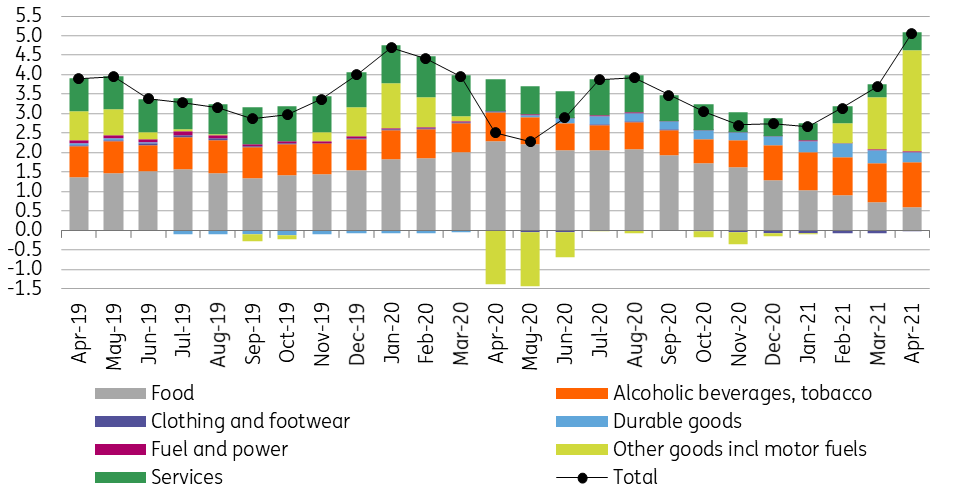Hungary: Inflation is back above 5%
Headline inflation significantly accelerated in April, reaching a level not seen since end-2012. Fuel and tobacco triggered the acceleration, and there's more to come
| 5.1% |
Headline inflation (YoY)ING forecast 4.9% / Previous 3.7% |
| Higher than expected | |
Inflation has started to move steeply upwards in recent months, as expected. In April, Hungarian headline inflation accelerated by 1.4ppt to 5.1% year-on-year, overshooting the market consensus. We can partly blame base effects as the oil price collapse last spring provides an exceptionally low base. However, the 0.8% increase in inflation from the previous month is also strong. The main drivers of inflation have remained the same, but there are signs that energy and non-energy commodity price increases have started to spill over into consumer prices.
Main drivers of headline CPI change (%)

- Fuel prices decreased by 1.2% on a monthly basis, but as a result of last year’s steep drop in oil prices, this translated into 39.2% YoY inflation. It explains roughly 2.3ppt of the headline CPI. This significant impact will start to fade from May as fuel prices started their rise in May 2020.
- Excise duty changes have remained a key element shaping inflation, mainly through tobacco. Prices in this product group rose by 20.1% on a yearly basis, which explains 1.2ppt of the headline reading. So, only two items are responsible for almost 69% of the general price pressure.
- But there is more. Durables prices increased by 0.3% on a monthly basis. With that, the yearly inflation reading has remained above 3% for the fourth month in a row. This reflects the strong demand in durables mixed with the supply chain issues (main chip shortage) which have increased the prices of electronic appliances, white goods and cars. Looking forward, based on commodity prices and rising producer prices, we see a significant risk that this will show up in consumer prices within six months.
- Inflation in food eased somewhat in general. However, prices of cereals, oils, fats and related processed food products started to pick up, showing the impact of increasing agricultural producer prices.
- Finally, we see the next round of inflation pressures coming from services as a result of the reopening of the economy. Although this started in April, due to data recording rules, it has barely affected services inflation (2% YoY) and we see a more significant impact in May.
The composition of headline inflation (ppt)

As the Statistical Office signalled earlier this month, it has revised the core inflation basket, leaving out alcoholic beverages and tobacco products. With this change, the new core inflation reading came in at 3.1% YoY, roughly 1ppt lower than the reading based on the old setup. Nonetheless, core inflation accelerated by 0.3ppt, so underlying price pressures are increasing too. This is reflected by the National Bank of Hungary's underlying inflation indicators too.
The updated core inflation reading (% YoY)

So-called sticky price inflation moved to 4.2% YoY, a record high in the past 13.5 years. The central bank’s core inflation reading, which excludes tax changes, also reflects the changes made by the Statistical Office. With that, there is not much difference between the two readings as the majority of the tax effect is coming from tobacco products.
Headline and core inflation measures (% YoY)

With a higher-than-expected April inflation, we see an upside risk to our 4.1% headline CPI forecast in 2021. The reopening-related inflation is ahead of us and we also expect producer price increases to spill over into consumer prices within the next six months. This could mean that headline inflation will remain above 4% through this year. Today’s inflation reading however won’t change the NBH’s imminent stance. As core inflation is within the tolerance band, the central bank can continue its wait-and-see approach. This could only be challenged by significant sell-side pressures on the forint, in our view. This will pose upside risks to inflation, in addition to the possible second round effects coming from reopening and commodity price shocks.
This publication has been prepared by ING solely for information purposes irrespective of a particular user's means, financial situation or investment objectives. The information does not constitute investment recommendation, and nor is it investment, legal or tax advice or an offer or solicitation to purchase or sell any financial instrument. Read more
Download
Download snap